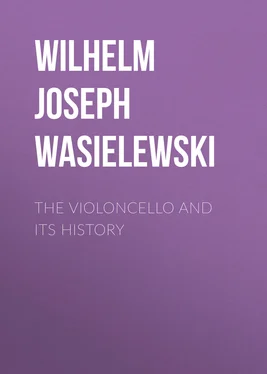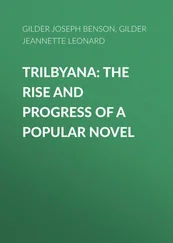Wilhelm Joseph von Wasielewski - The Violoncello and Its History
Здесь есть возможность читать онлайн «Wilhelm Joseph von Wasielewski - The Violoncello and Its History» — ознакомительный отрывок электронной книги совершенно бесплатно, а после прочтения отрывка купить полную версию. В некоторых случаях можно слушать аудио, скачать через торрент в формате fb2 и присутствует краткое содержание. Жанр: foreign_antique, foreign_home, music_dancing, на английском языке. Описание произведения, (предисловие) а так же отзывы посетителей доступны на портале библиотеки ЛибКат.
- Название:The Violoncello and Its History
- Автор:
- Жанр:
- Год:неизвестен
- ISBN:нет данных
- Рейтинг книги:3 / 5. Голосов: 1
-
Избранное:Добавить в избранное
- Отзывы:
-
Ваша оценка:
- 60
- 1
- 2
- 3
- 4
- 5
The Violoncello and Its History: краткое содержание, описание и аннотация
Предлагаем к чтению аннотацию, описание, краткое содержание или предисловие (зависит от того, что написал сам автор книги «The Violoncello and Its History»). Если вы не нашли необходимую информацию о книге — напишите в комментариях, мы постараемся отыскать её.
The Violoncello and Its History — читать онлайн ознакомительный отрывок
Ниже представлен текст книги, разбитый по страницам. Система сохранения места последней прочитанной страницы, позволяет с удобством читать онлайн бесплатно книгу «The Violoncello and Its History», без необходимости каждый раз заново искать на чём Вы остановились. Поставьте закладку, и сможете в любой момент перейти на страницу, на которой закончили чтение.
Интервал:
Закладка:
Another Italian cellist of that time was Domenico della Bella, of whom nothing further is known than that, in 1704, he published, in Venice, Twelve Sonatas “a due violini e violoncello.”
The information is equally meagre regarding the cellist Parasisi, of whom Gerber says he was an extraordinary artist on his instrument and was with the Italian Opera orchestra at Breslau in 1727.
Concerning the Italian violoncellists Jacchini, Amadio, Vandini, Abaco, dall’Oglio, and Lanzetti, born in the second half of the seventeenth and the beginning of the eighteenth century, we know very little.
Jacchini, whose Christian name was Giuseppe, noted by Gerber as one of the first cellists of his time, was appointed to the church of S. Petronio in Bologna at the beginning of the eighteenth century. That he had distinguished himself as an artist is proved by his nomination as a member of the Bologna Philharmonic Society, a distinction which is only conferred on men of great musical reputation. Of his compositions there is a work entitled “Concerti per Camera a 3 e 4 stromenti, con violoncello obligato (Op. 4). Bologna, 1701,” to be mentioned.
Pippo Amadio, who flourished about the year 1720, was, according to Gerber’s account, a violoncellist, “whose art surpassed all, that up to his time had been produced on his instrument.”
Antonio Vandini, first violoncellist at the church of S. Antonio, Padua, seems to have been no less remarkable. The Italians called his manner of playing and his expression “parlare”—he understood how to make his instrument speak. He was on terms of such close friendship with Tartini, who as is known was engaged at the same church at Padua as solo violinist, that he accompanied him in 1723 to Prague, and remained with him for three years in the service of Count Kinski. Vandini was still living in Padua in 1770. The year of his death is unknown.
Abaco, born at Verona, according to information contained in the second year of the “Leipsic Musical Paper” (p. 345), was a prominent violoncellist, who lived in the first half of the eighteenth century. Gerber possessed a cello solo of his composition, of which he says that it appeared to have been written in the year 1748.
Giuseppe dall’Oglio, the younger brother of the famous violin player, Domenico dall’Oglio, was born about 1700 at Padua, 63 63 Gerber gives Venice as his birthplace; but in the Weekly News of the year 1770, Padua is mentioned, which is probably correct.
and went to St. Petersburg in 1735. There he remained in the Russian imperial service twenty-nine years, after which he returned to his native land. On his journey thither he stopped at Warsaw, on which occasion King August of Poland nominated him his agent for the Venetian Republic.
Salvatore Lanzetti, born at the beginning of the eighteenth century in Naples, was pupil of the Conservatorio there, Santa Maria di Loreto, and was during the greater part of his life in the service of the King of Sardinia. He died in Turin in 1780. In the year 1736 two volumes of violoncello sonatas appeared by him, and later also a book of instruction, the title of which Fétis gives as: “Principes du doigter pour le Violoncelle dans tous les tons.” It is somewhat differently named by Gerber: “Principes ou l’applicatur de Violoncel par tous les tons.” Lanzetti must have carried out with great skill the staccato touch both up and down the instrument.
We are somewhat better informed regarding the violoncellist Caporale. Neither the place of his home nor the year of his birth nor that of his death are, indeed, known to us, but of his life and work in England we possess some information. In 1735 he came to London and worked under Handel, who wrote for him a cello solo in the third act of his opera “Deidamia” composed in 1739.
His musical education could not have been very thorough, but he must have had certain qualifications which induced Handel to connect himself with him. Simpson’s Collection (see p. 49), published in London, contains a Cello Sonata by Caporale, which does not speak much for his talent in composition. It consists of Adagio , Allegro , and a Theme with three variations after the manner of studies. As a player Caporale was remarkable for his tone, but as regards finish he could not rival either the elder Cervetto or Pasqualini.
This last-named artist, by whom a sonata, scarcely rising above the level of Caporale, was contained in the volume already mentioned as appearing at Simpson’s, was performing in London, in 1745, as a concertist of great repute. Further information regarding him does not exist.
Greater consideration must be yielded to Carlo Ferrari, brother of the violinist Domenico Ferrari, so often referred to in the previous century. On account of an injured foot he was called “the lame.” Born at Piacenza about 1730 he betook himself to Paris in 1758 and appeared with great success in the “Concert Spirituel.” In 1765 he accepted an engagement offered to him by the Count of Parma. 64He remained in this position until his death, which took place in 1789. It is reported of Ferrari that he was the first Italian cellist who made use of the thumb position. If this be true, France must have been beforehand in the difficult matter of the art of fingering; for the thumb position was already known in Paris, as we have seen, before 1740, consequently at a time when Ferrari was only ten or twelve years old. But if it be acknowledged that violoncello playing was cultivated much earlier in Italy than in France, and had already advanced beyond the elemental stage before it had found representatives among the French, we must be inclined to concede to the Italians the discovery of the thumb position, and indeed to the predecessors of Ferrari. It is highly probable that Franciscello and Batistin already availed themselves of its assistance for the use of the upper parts of the fingerboard. The trick must have been brought into France by the last-named artist who, as we know, settled in Paris at the beginning of the eighteenth century.
The proof that the thumb position was known in Paris before 1740 is established by the violoncello method of Michel Corrette in the year 1741, and which, as far as one can see, was the first work of instruction for the instrument in question. Considering the scarcity at that time of cello compositions this instruction book is the more important, as from it is to be determined with certainty the average standard to which violoncello playing had attained towards the middle of the previous century. This circumstance seems to justify our entering somewhat more fully into Corrette’s school.
The title is: “Méthode, théoretique et pratique, pour apprendre en peu de temps, le violoncelle … dans sa perfection composée par Michel Corette. XXIV eOuvrage à Paris, chez l’auteur, M eBoivin et le S rle Clerc; à Lyon chez M. de Bretonne. Avec Privilège du Roy. MDCCXL1.” 65
After some introductory paragraphs regarding the use of the F and C clef, in notation for violoncello music, concerning the value of notes and pauses, the formation of sharps, flats, and naturals, as well as regarding the usual marks, the various measures and syncopes, Corrette treats:
1. Of the manner of holding the violoncello; 2. Of the holding and action of the bow; 3. Of its use in the up and down strokes; 4. Of the tuning of the violoncello; 5. Of the division of the fingerboard into diatonic as well as chromatic tones; 6. Of the fingering in the lower (first) and following positions; 7. Of the way and manner of returning from the higher positions to the first; 8. Of trills and appogiaturas; 9. Of the various kinds of bow action; 10. Of double-stops and arpeggios; 11. And also of the thumb position. He also gives instruction for those who wish to go from the gamba to the violoncello, and then in conclusion gives hints for the accompaniment of singing and for instrumental solos.
Читать дальшеИнтервал:
Закладка:
Похожие книги на «The Violoncello and Its History»
Представляем Вашему вниманию похожие книги на «The Violoncello and Its History» списком для выбора. Мы отобрали схожую по названию и смыслу литературу в надежде предоставить читателям больше вариантов отыскать новые, интересные, ещё непрочитанные произведения.
Обсуждение, отзывы о книге «The Violoncello and Its History» и просто собственные мнения читателей. Оставьте ваши комментарии, напишите, что Вы думаете о произведении, его смысле или главных героях. Укажите что конкретно понравилось, а что нет, и почему Вы так считаете.












![Edward Ellis - Adrift on the Pacific - A Boys [sic] Story of the Sea and its Perils](/books/753342/edward-ellis-adrift-on-the-pacific-a-boys-sic-s-thumb.webp)